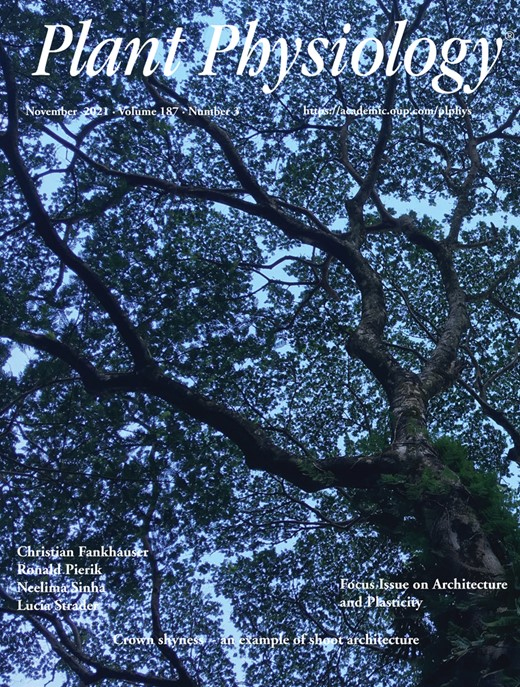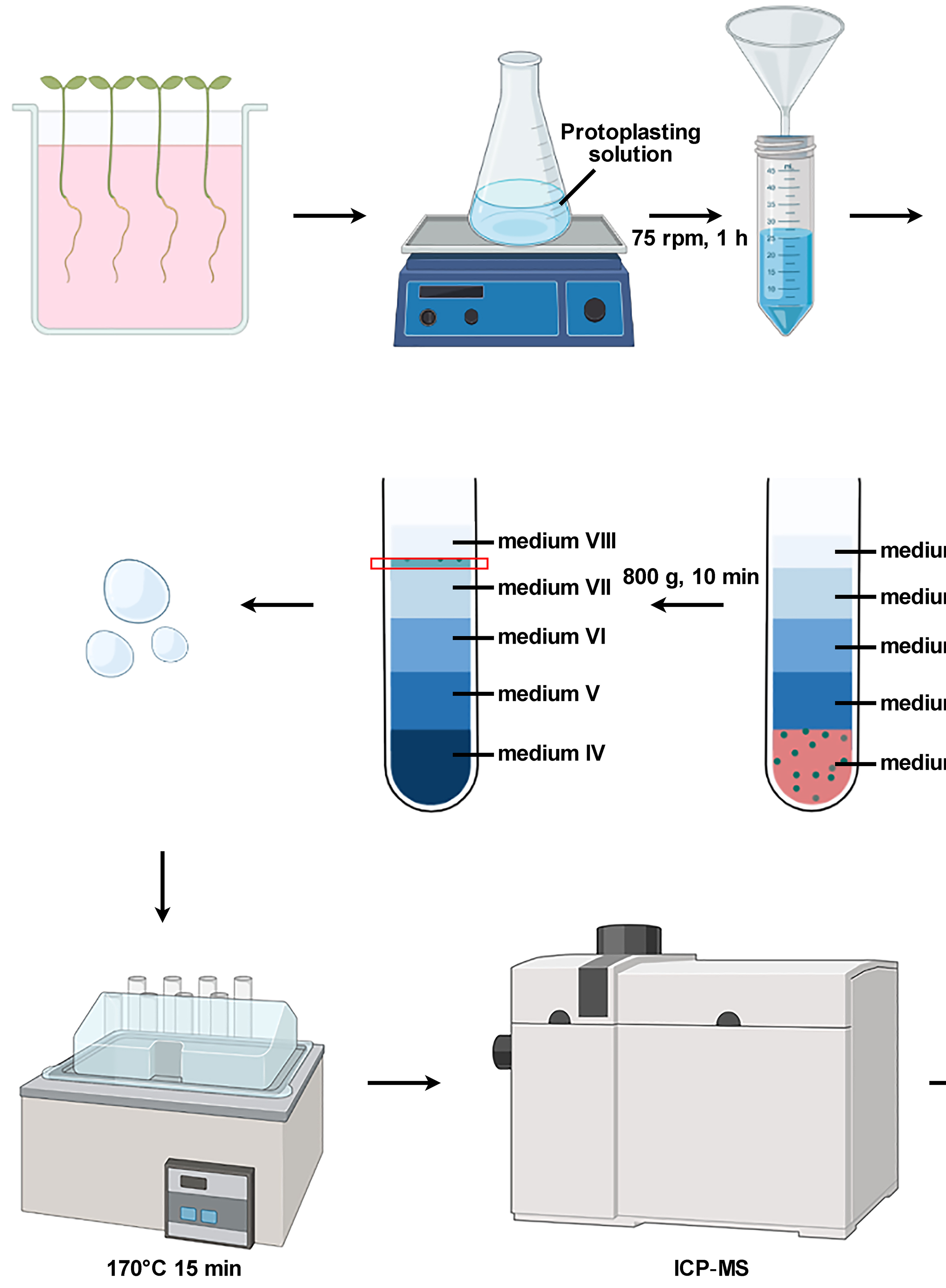- EN - English
- CN - 中文
A Quick Method to Quantify Iron in Arabidopsis Seedlings
一种快速定量拟南芥幼苗中铁的方法
(*contributed equally to this work) 发布: 2022年03月05日第12卷第5期 DOI: 10.21769/BioProtoc.4342 浏览次数: 3642
评审: Wenrong HeKevin RobeMin Cao
Abstract
Iron (Fe) is an indispensable micronutrient for plant growth and development. Since both deficiency, as well as a surplus of Fe, can be detrimental to plant health, plants need to constantly tune uptake rates to maintain an optimum level of Fe. Quantification of Fe serves as an important parameter for analyzing the fitness of plants from different accessions, or mutants and transgenic lines with altered expression of specific genes. To quantify metals in plant samples, methods based on inductively coupled plasma-optical emission spectrometry (ICP-OES) or inductively coupled plasma-mass spectrometry (ICP-MS) have been widely employed. Although these methods are highly accurate, these methodologies rely on sophisticated equipment which is not always available. Moreover, ICP-OES and ICP-MS allow for surveying several metals in the same sample, which may not be necessary if only the Fe status is to be determined. Here, we outline a simple and cost-efficient protocol to quantify Fe concentrations in roots and shoots of Arabidopsis seedlings, by using a spectroscopy-based assay to quantify Fe2+-BPDS3 complexes against a set of standards. This protocol provides a fast and reproducible method to determine Fe levels in plant samples with high precision and low costs, which does not depend on expensive equipment and expertise to operate such equipment.
Keywords: Arabidopsis (拟南芥)Background
Iron (Fe) is an essential micronutrient, which is involved in numerous biochemical and physiological processes in plants. A deficiency or an excess of Fe in plants limit plant growth and cause severe losses in crop yield and quality. Imbalances of Fe levels in plants also affect the homeostasis of other nutrients (Schmidt et al., 2020). Therefore, the determination of Fe concentrations in plant tissues is mandatory for the assessment of the nutritional status of the plant and serves as an important parameter for studying Fe-related genes. Currently, inductively coupled plasma (ICP) spectrometry-based methods are considered the gold standard for determining Fe levels. Although these methods are highly sensitive and reliable, their accessibility is rather limited due to costly equipment, specialized training required for the operation of such equipment, and the requirement of generally large amounts of material, which may render the analysis difficult in cases where sample size is limited. Therefore, a simple, reliable, and easily accessible method to measure Fe levels at high accuracy is a valuable alternative to ICP-based methods.
Here, we describe a method for quantifying total Fe in roots and shoots of plant seedlings. The method is based on a protocol established for the analysis of Fe concentration in Plantago lanceolata L. leaves (Schmidt, 1996), which we have adapted and optimized for convenient and routine analysis of the more commonly used model plant Arabidopsis thaliana. The method involves wet acid digestion of dried plant samples with nitric acid and hydrogen peroxide, to solubilize Fe and reduction of Fe(III) complexes by hydroxylammonium chloride, followed by a colorimetric assay based on the ability of the chelating agent bathophenanthroline disulfonate (BPDS) to form red-colored complexes with ferrous Fe. The resulting Fe2+(BPDS)3 complex has a distinct absorbance band at 535nm under acid conditions, allowing for the quantification of Fe concentrations by interpolation from a standard curve. BPDS has been widely used for the determination of Fe levels in a variety of samples (Pré and Benlatrèche, 1977; Tangerås, 1983; Hirayama and Nagasawa, 2017; Freinbichler et al., 2020). The present protocol was optimized for Arabidopsis thaliana samples, and has been used for quantifying Fe concentrations as low as 50 μg/g dry weight sample or less (Tsai et al., 2018; Gautam et al., 2021), but can be modified and applied to determine Fe levels in samples from other plant species.
Materials and Reagents
Butter paper
Tissue paper/Kimwipes
15 mL screw cap conical tubes (Sarstedt, catalog number: NC1377856)
96-well microplate (Greiner CELLSTAR®, catalog number: 655180)
Nitric acid (65%) (Merck, catalog number: 1.00456.1000, store at room temperature)
Hydrogen peroxide solution (30%) (Merck, catalog number: 1.07209.1000, store at room temperature)
ddH2O
Bathophenanthrolinedisulfonic acid disodium salt hydrate (Sigma, catalog number: B1375-5G, store at room temperature)
Sodium acetate (Sigma, catalog number: S8750-500G, store at room temperature)
Hydroxylamine hydrochloride (Alfa Aesar, catalog number: A15398.36, store at room temperature)
Iron (III) chloride hexahydrate (Merck, catalog number: 1.03943.0250, store at room temperature inside a dry cabinet)
Assay solution (see Recipes)
Fe standard solutions (see Recipes)
Equipment
Vannas scissors
Drying oven (Hot air oven, PREMA®)
Vortex mixer (Vortex-Genie 2, Scientific Industries)
Heat block (Elite Dry Bath Incubator, Major Science)
Microplate spectrophotometer (Power Wave XS2, BioTek Instruments, Agilent Technologies)
Software
Gen5TM BioTek Instruments (Agilent Technologies)
GraphPad Prism version 9
Procedure
文章信息
版权信息
© 2022 The Authors; exclusive licensee Bio-protocol LLC.
如何引用
Readers should cite both the Bio-protocol article and the original research article where this protocol was used:
- Gautam, C. K., Tsai, H. H. and Schmidt, W. (2022). A Quick Method to Quantify Iron in Arabidopsis Seedlings. Bio-protocol 12(5): e4342. DOI: 10.21769/BioProtoc.4342.
- Gautam, C. K., Tsai, H. H. and Schmidt, W. (2021). IRONMAN tunes responses to iron deficiency in concert with environmental pH. Plant Physiol 187(3): 1728-1745.
分类
植物科学 > 植物生理学 > 营养
环境生物学 > 植物
植物科学 > 植物生物化学 > 其它化合物
您对这篇实验方法有问题吗?
在此处发布您的问题,我们将邀请本文作者来回答。同时,我们会将您的问题发布到Bio-protocol Exchange,以便寻求社区成员的帮助。
提问指南
+ 问题描述
写下详细的问题描述,包括所有有助于他人回答您问题的信息(例如实验过程、条件和相关图像等)。
Share
Bluesky
X
Copy link












